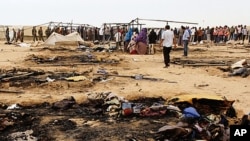Many sub-Saharan migrants remain stranded in Libya as the conflict there continues. Most are from Ghana, Togo, Sudan, Nigeria and Cameroon, but many Malian and Egyptian migrants are also unable to return home.
The International Organization for Migration [IOM] says the migrants, often unskilled and undocumented, have been without jobs since the crisis began.
Only estimates
“What we know prior to the crisis in Libya is that there were literally hundreds of thousands of African migrant workers in Libya,” said IOM spokesman Jean Philippe Chauzy.
A more accurate estimate has been hard to come by because so many are undocumented and not registered with their embassies.
“Over the past four months, we’ve seen an exodus of migrant workers out of Libya. In excess of 900,000 people have left the country, have fled the country. That being said, there are probably tens of thousands of stranded migrant workers…that are still in Libya and cannot leave the country for security reasons or simply because they can’t afford to leave the country,” he said.
IOM teams are trying to locate the migrants in Tripoli and elsewhere and determine their humanitarian needs. After that, arrangements would be made to evacuate them, most likely to Tunisia or Egypt.
“We are also concerned about the plight of African workers, who are fleeing Libya, and arriving in very, very difficult and desperate circumstances in countries like Chad and in Niger,” he said.
IOM is working with both Libyan authorities and diplomatic missions to determine just how many migrant workers remain in the country.
“That’s quite a difficult job,” Chauzy said, “Many of those nationals from sub-Saharan Africa…were smuggled into Libya and were employed in the informal sector of the Libyan economy and therefore were totally invisible to the diplomatic missions and to the humanitarian community inside Libya.
Many migrants are also trying to make their way to neighboring Egypt.
“We’ve now had an outflow of migrant workers, mostly from eastern Libya into Egypt. The outflow continues and includes obviously migrant workers from African countries, but also from Asia. We also have migrant workers that are still continuing to come out through the Tunisian border. But our concern and our focus remains also very much on northern Niger and northern Chad,” he said.
He described the journey to Niger and Chad as “incredibly dangerous,” taking them across the desert in southern Libya. Once they cross the border, they face another long journey to find towns capable of providing humanitarian assistance.
“People who are arriving in those localities are usually completely exhausted simply because of the sheer difficulty they have faced,” Chauzy said.
Misrata
IOM has used the port of Misrata to evacuate migrants and others from Libya. Boats carry them to Benghazi.
“To date, we’ve evacuated about 7,200 stranded migrant workers out of Misrata. We’ve also managed every single time the boat went into Misrata to bring in hundreds of tons of humanitarian aid to the population of Misrata, including medical assistance. We’ve evacuated wounded people out of Misrata. Obviously, the needs in Misrata remain enormous,” he said.
IOM has helped evacuate about 31,000 people from Libya so far, including its Misrata operations.














